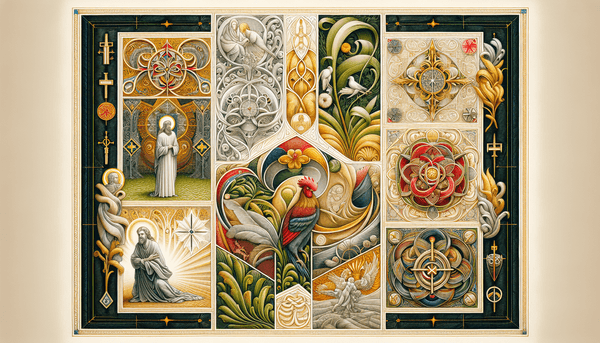The Anointing at Bethany
Matthew 26:8-12 captures a scene brimming with tension and beauty as a woman's act of anointing Jesus is met with indignation from the disciples. They see waste where Jesus sees worship; they measure the moment's value with the currency of the poor, while He measures it with the imminence of His burial. Jesus' response is both a rebuke and a revelation—affirming the significance of the poor (Deuteronomy 15:11) and the eternal value of honoring the divine presence among us. This act of anointing, also recounted in John 12:3-8, becomes a testament to the power of devotion, as Jesus likens the woman's act to the prophetic mission announced in Isaiah 61:1, where the anointed one brings good news to the afflicted. He invites His followers to consider the depth of their own commitment to Him, challenging them to live out the love they profess, as urged in 1 John 3:17.
The First Seal in Revelation 6:2
The cryptic tapestry of Revelation unfurls as the first of seven seals is broken, revealing a white horse whose rider, armed with a bow and crowned, sets forth conquering and to conquer (Revelation 6:2). This figure, shrouded in controversy, has been interpreted by some as the Antichrist, by others as a harbinger of Christ's victory. The white steed, often associated with purity and triumph, charges through the eschatological landscape, echoing the victorious return of Christ on a white horse as described in Revelation 19:11. The imagery of the horsemen draws from Zechariah's visions (Zechariah 1:8) and carries with it the weight of Daniel's apocalyptic prophecies (Daniel 7:13-14), where dominion is an everlasting dominion. Yet, amid these interpretations, Jesus' caution in Matthew 24:4-5 remains a guiding beacon, warning against deception by false Christs in tumultuous times.
The Seven Seals in Revelation
The Book of Revelation, a mosaic of apocalyptic visions, presents the seven seals as a divine unveiling of events leading up to Christ's return. Each seal, when broken, heralds a portion of the celestial blueprint, drawing the curtain back on the theater of the end times. The seals, as disclosed in Revelation 5:1 and 6:1-17, reveal a succession of earthly and heavenly occurrences that crescendo until the seventh seal ushers in a hushed awe in heaven (Revelation 8:1). These moments mirror the signs of the end times that Jesus describes in Matthew 24:6-8 and carry a reminder akin to Paul's words to the Thessalonians about the Day of the Lord arriving like a thief in the night (1 Thessalonians 5:2). As we ponder these prophecies, we are reminded that they serve not to instill fear but to prepare hearts for the ultimate victory and hope found in Christ.
Conclusion
In our journey through these biblical passages, we have seen the depth of Jesus' awareness of His sacrificial role, the beauty of true worship in the face of practical concerns, and the complex tapestry of end-time prophecies. We are reminded that personal devotion and social responsibility are not mutually exclusive but are intertwined in the teachings of Christ. As we continue to seek understanding, may we be guided by faith, study, and prayer, embracing the diverse insights that enrich our spiritual walk. Let us hold fast to the hope that, despite the many interpretations, the central message of Christ's victory and love remains the unshakeable foundation of our faith.
FAQ
Q: What does Matthew 26:2-5 mean?
A: This passage reveals a significant moment in Jesus' life as he foretells his impending crucifixion to his disciples. It also depicts the chief priests and elders plotting to arrest and kill Jesus, albeit not during the Passover festival to avoid public outcry. This sets the stage for the profound events that unfold in the subsequent chapters of the Gospel, ultimately leading to the crucifixion and resurrection of Jesus.
Q: What does Matthew 26:8-12 mean?
A: This passage recounts the moment when a woman poured expensive perfume on Jesus, and the disciples were critical of her actions, questioning the value of the perfume. Jesus responded by affirming the woman's gesture as a beautiful act of devotion, acknowledging that she was preparing him for his impending death and burial. He also emphasized the enduring importance of caring for the poor, while recognizing the significance of the woman's act in honoring him.
Q: What is the significance of the first seal in Revelation 6:2?
A: The first seal in Revelation introduces a white horse and its rider, who is often interpreted as a figure of conquest and victory. The rider carrying a bow and being given a crown could represent the Antichrist or other powerful figures in the end times. This image is a part of the broader context of the seven seals, which symbolize events leading up to the final judgment and return of Christ.
Q: How should we interpret the Book of Revelation and its prophecies?
A: The Book of Revelation is a complex and symbolic text that has led to various interpretations. It is meant to be read with discernment and an understanding that some aspects may remain mysterious. Christians are encouraged to approach Revelation with humility, seeking wisdom through the Holy Spirit, and focusing on the overarching message of hope and victory in Jesus Christ, rather than getting lost in speculative details.






